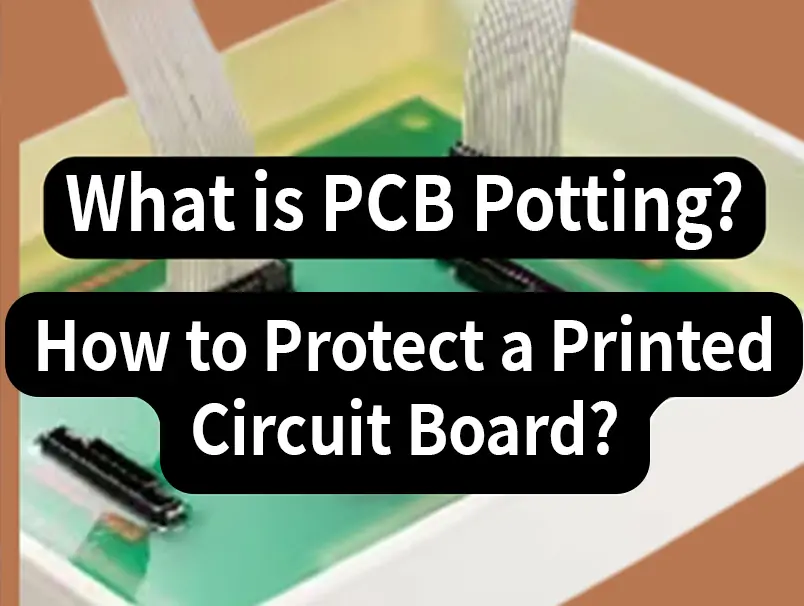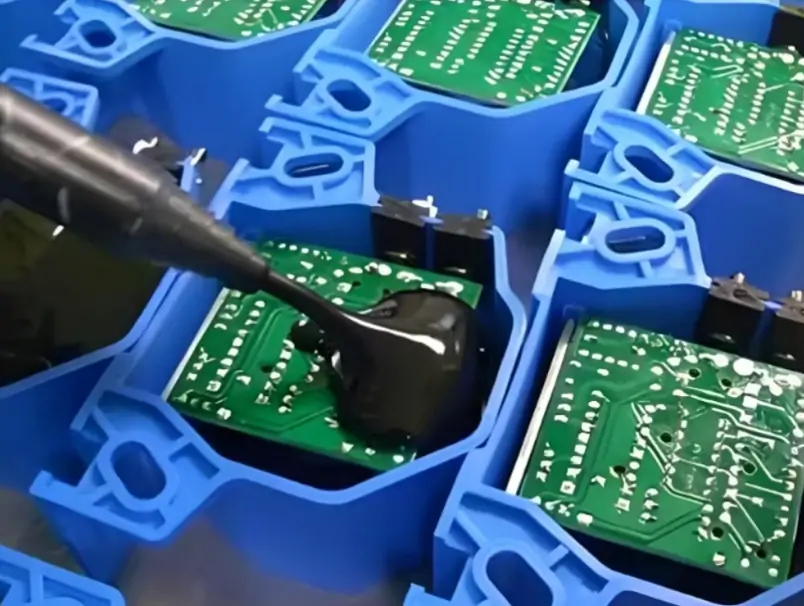Global high-mix volume high-speed Shenzhen PCBA manufacturer

Ru
9:00 -18:00, Mon. - Fri. (GMT+8)
9:00 -12:00, Sat. (GMT+8)
(Except Chinese public holidays)





Global high-mix volume high-speed Shenzhen PCBA manufacturer

Ru
9:00 -18:00, Mon. - Fri. (GMT+8)
9:00 -12:00, Sat. (GMT+8)
(Except Chinese public holidays)





HomePage > Blog > Knowledge Base > What is PCB Potting? | One Printed Circuit Board Protective Coating
Electronics is a subsector of technologies where PCBs are very significant in adhesion devices. PCB potting is a general term that may comprise the positioning and encapsulation of passionate constituents with protection material.
Circuit board potting is essential since it assists in shielding fragile constituents from forces such as water, dust, and vibration. Thus, potting occupies its place in the manufacturing process since it contributes to extending the durability of the items, which is apparent through the encasing of the PCB, in particular.

By reading the article, you will understand what PCB potting is, what types of PCB protective coating are, and the benefits of this procedure to the manufacturer and the end-user.
PCB potting materials can be categorized into several types, and these types of materials are quite different from each other in their usage characteristics. Some of the most common molding materials are epoxy resin, silicone rubber, and polyurethane, and all of them offer critical protection to electronics depending on the environmental and operational requirements.
Epoxy Resin:
Epoxy is particularly suitable for potting electronics because it is very sticky and has excellent mechanical properties. It provides a perfect shield against environmental influences like moisture, chemicals and physical strain and is ideal for rough surfaces.
Silicone:
Silicone potting compounds are a favorite because of their elasticity and higher thermal conductivity. Because of these characteristics, silicone is suitable for use wherever parts are subjected to variations in temperature. Mechanically, it is also flexible and thus can take mechanical stress and protect more delicate parts.
Polyurethane:
The flexibility and rigidity of polyurethane provide significant versatility to this polymer. It is mainly used in applications involving impact together with insulated electrical conductivity, which serves numerous industrial uses.
Knowledge of these materials and areas of use is necessary while choosing the correct form of potting electronic parts so that they receive the best form of safeguard and functioning.
Conformal coating and potting can both be used to protect electronic components; however, they do not work in the same manner or are applied in a different way. Conformal coating is a technique whereby a thin layer is applied on the surface of the PCB to protect it from environmental aspects such as moisture and dust in a lightweight manner.
Potting covers the entire PCB in a very durable protective layer and affords more protection in conditions where others fail. In the case of conformal coating vs potting, the decision of which one to use depends on the particularities of usage.
Conformal coating is most suitable where weight and space are not very important, while potting is most suitable where there is a need for maximum protection. It is vital to appreciate these differences to make the right choice when it comes to the protection of PCBs.

Key Areas to Differ: Conformal Coating VS Potting
Level of Protection:
PCB potting involves enclosing, while conformal coating covers the external part of the equipment.
Material Usage:
Potting uses more material and protects the whole PCB area, while conformal coating puts a layer.
Mechanical Strength:
Potting increases rigidity to a large extent. While the conformal coating is more lightweight and flexible in operation.
Thermal Management:
Potting does have benefits when it comes to the dissipation of heat compared to conformal coating, where the difference is irrelevant.
Application Environment:
Conformal coating is advised to be used in dusty and damp environments. PCB potting is best for moist, rainy, abrasive and worst environmental conditions.
PCB has to be potted for many reasons, but primarily because of improvements in life and the reliability of one or more electronic parts in severe environments. Here's why potting PCB is necessary:
Physical Protection:
Erection of PCB in potting form develops a shield; it ensures the sensitive components within the PCB are shielded from any force, such as jerks, vibrations, or anything.
Increased Durability and Reliability:
These are coated over the PCB with a protective material; this makes the device much more reliable as it is protected from harsh conditions, thus making its lifetime gallantly.
Electrical Insulation:
PCB Potting provides electrical insulation that ensure safety of electrical circuit. In this way your device lifespan increases, and you get hassle free experience.
Environmental Resistance:
Potting encases PCB blocks moisture, dust, and chemicals. Thus, products made to be fine for use in unfriendly environments are made.
Thermal Management:
Heat could be a major nonfunctional factor in PCB materials. Potting of PCB materials can help handle heat so that temperatures at which the boards perform best will be maintained.
All these benefits map a picture of why there is a need for potting PCBs in the protection of electronic gadgets.
PCB potting compound refers to a material applied to encapsulate and safeguard components on a printed circuit board or PCB. This compound provides a buffer to the components from various factors that may affect them, including moisture, dust, chemicals and mechanical stress. Compounds like epoxy, silicone, and polyurethane have the ability of adhesion, flexibility, or heat resistance that distinguishes general potting compounds.
It is, therefore, necessary for a user to evaluate the best potting compound for their application. These are the working environment, security requirements, and the heat dissipation capacity of the equipment. Therefore, proper selection of the potting compound would enable protection and maximize the efficiency of the PCB in different environmental conditions.

How to Choose PCB Potting Material in the Potting Process?
In the potting process, selecting the right material for potting your PCB is of the utmost importance for the functionality of the potting and your own printed circuit board. Here's a guide to selecting the appropriate potting materials:
Assess the Environment:
When choosing a durable material for PCB potting, the most important thing is to assess the environmental condition where you want to use it. For example, silicone potting material is suitable for conditions where temperatures vary drastically, as epoxy provides excellent chemical protection.
Consider Mechanical Stress:
Determine the degree of physiologic load that the PCB shall handle. Polymers such as polyurethane provide flexibility and capacity to deal with vibration and shock, which is why they are ideal for applications with vibrations or shocks.
Check Electrical Insulation Requirements:
Make sure that the potting material to be used can insulate the electrical circuit, not short circuit, and at the same time ensure operation safety. Like epoxy, as well as silicone, are used most often as insulators due to their specific characteristics.
Thermal Management:
Choose a potting media that will allow heat to be dissipated well in the case of an increase in temperature. Epoxies are some of the materials that assist in controlling thermal loads and protect against overheating.
Application Specifics:
Think, for example, of the ability to apply it and its curing time. Potting materials can have specific special requirements on how they will be handled or processed once applied, affecting the production line.
Thus, with proper ratings of these aspects, you will be able to select the right potting material and get the best performance and dependable PCB out of it.
1) What is the Protective Coating?
Protective coating is a method that is characterized by putting on a thin layer of protective material on electronic gadgets. This protective material, of course, is primarily used to protect the circuit board potting from moisture, dust, and chemicals.
2) What is Conformal Coating?
Conformal coating is a protective coating that is used at the exterior layer of circuits on the PCB to shield the circuit from some factors such as moisture, dust, chemicals, and fluctuating temperatures. This coating can also include the form of the PCB to provide a kind of shield that makes the electrical components more robust.
3) Types of Conformal Coating
The conformal coating consists of 4 types: Acrylic coating, Silicone coating, Polyurethane coating, and Epoxy coating. Conformal coating enhances the lifetime and dependability of PCBs through the shielding of the elements from the formation of voids, which are well known to lead to the degradation of the thermal conductivity and mechanical structures of the boards.
4) What is PCB Encapsulation?
PCB encapsulation is one of the processes in which the surface of the PCB is fully covered with protective material, generally with resin. Since it is better than a mere surface coating, it offers wide coverage.
5) PCB Potting VS PCB Encapsulation
As mentioned earlier, both potting and encapsulation offer pretty good protection; nevertheless, potting involves filling up a cavity with a protective material, while in encapsulation, the whole PCB is coated by epoxy resin.

Assembly Enquiry
Instant Quote